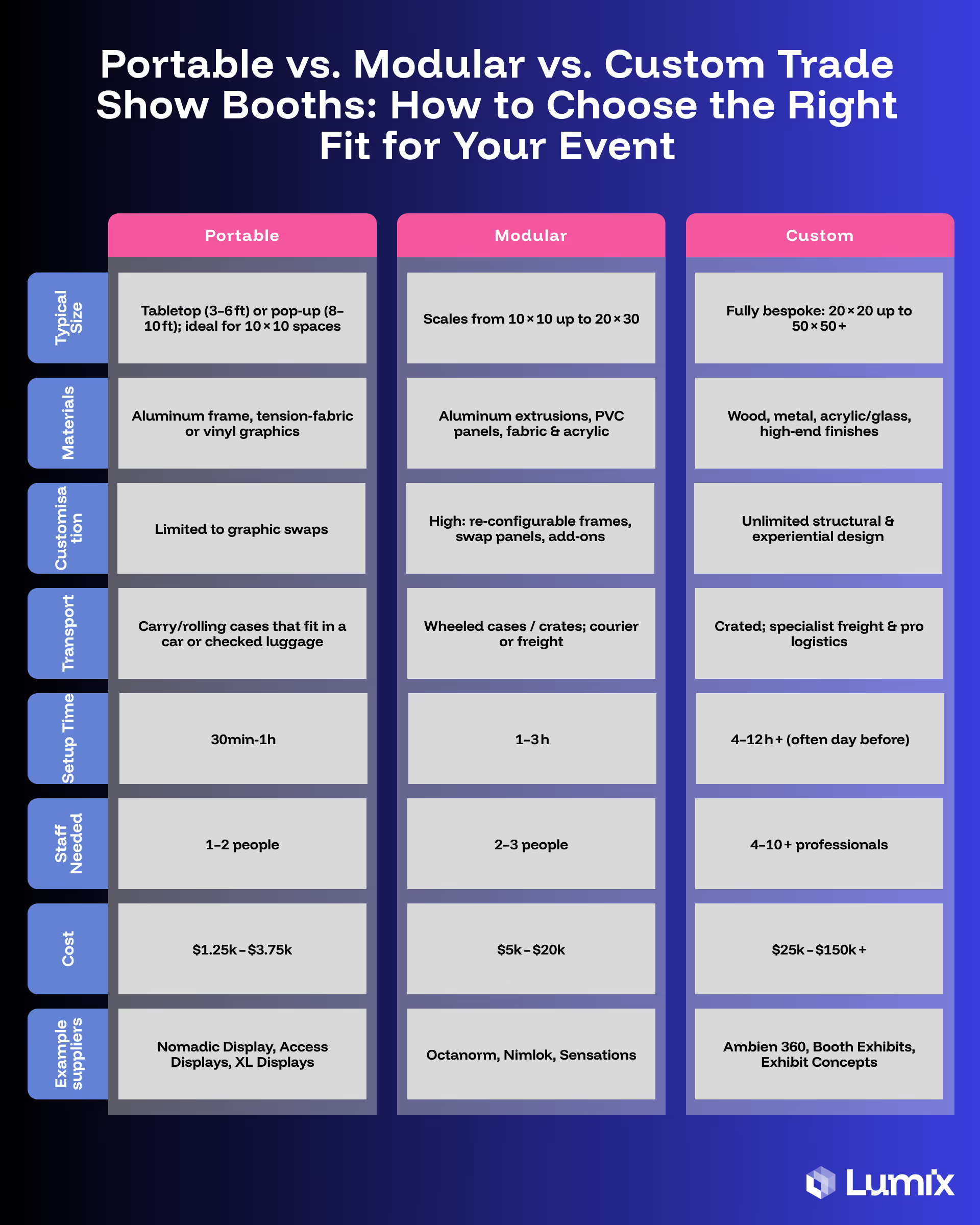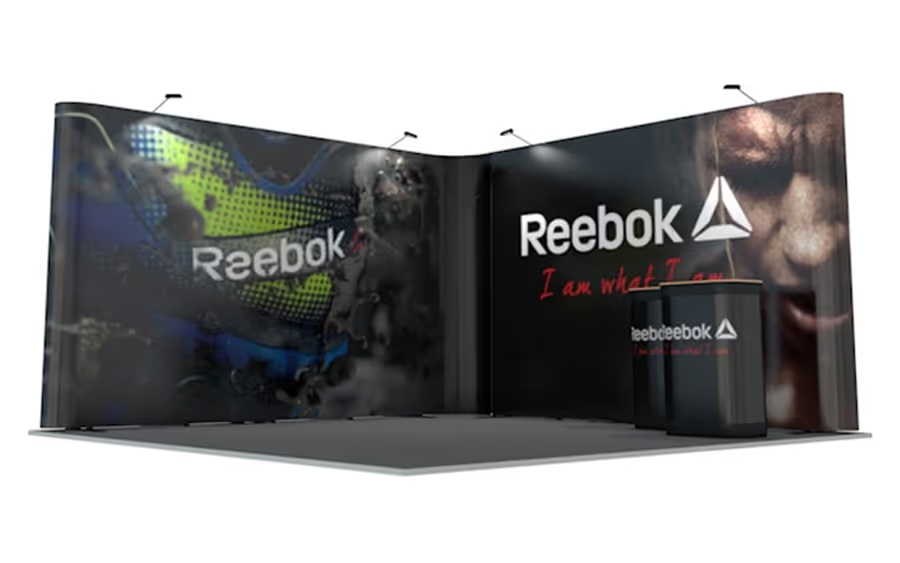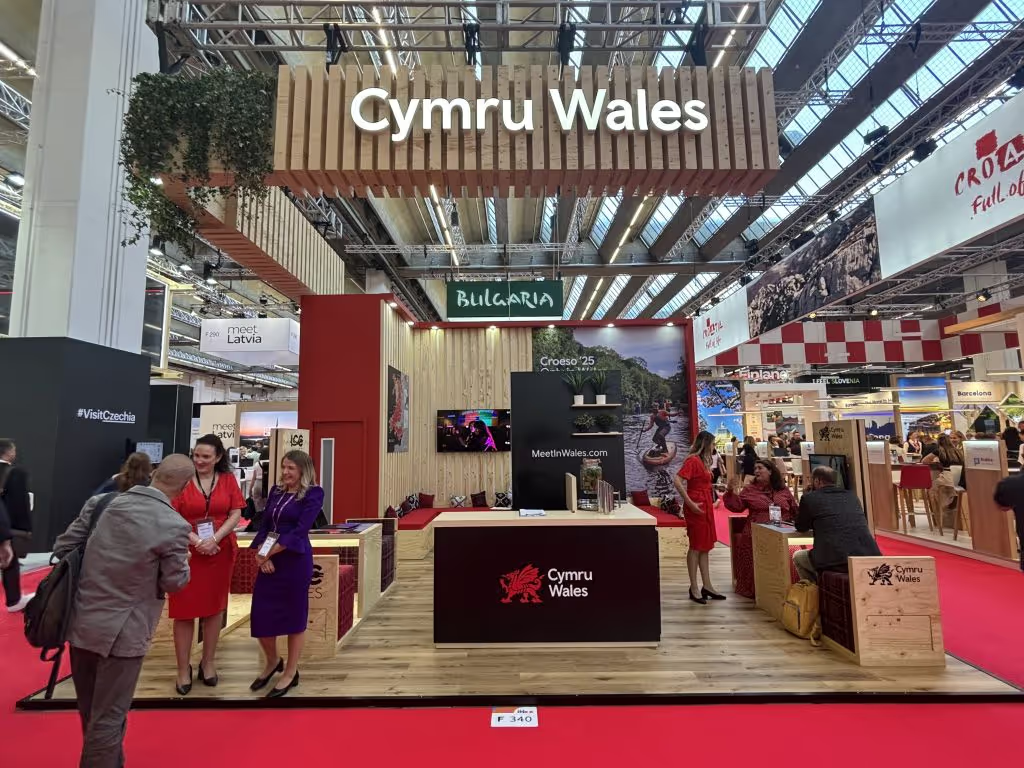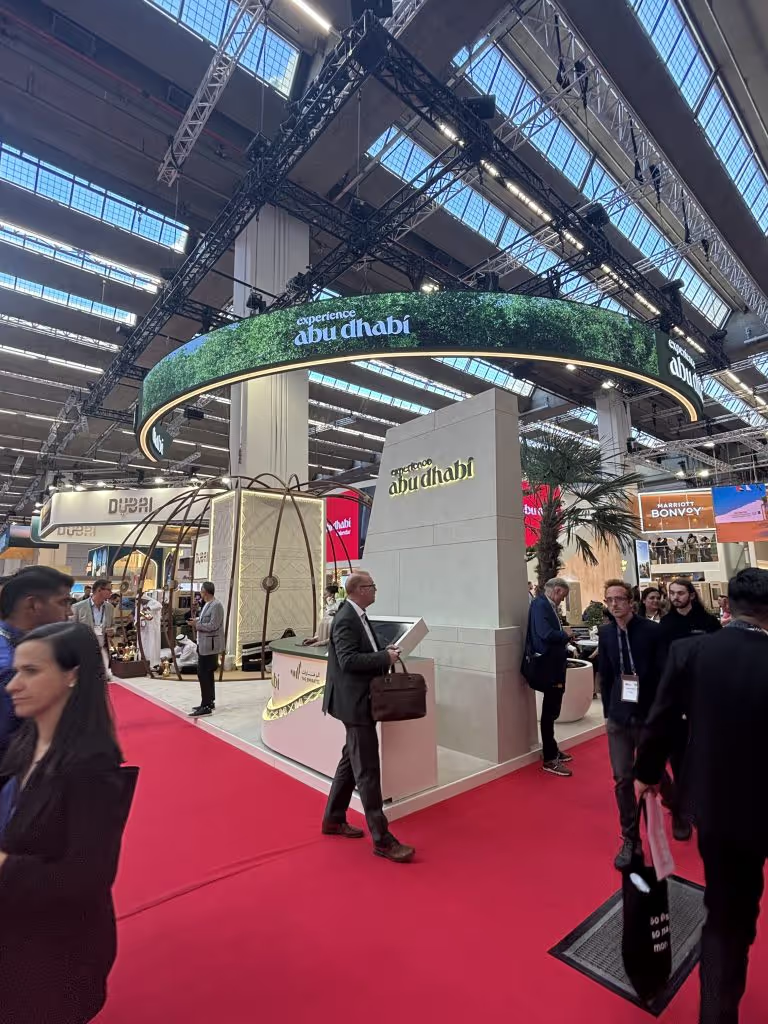Portable vs Modular vs Custom Trade Show Booths: How to Choose the Right Fit for Your Event

Weekly newsletter
Introduction
Events represent the largest chunk of non-digital marketing spend, according to Gartner, yet we consistently see event marketers making booth decisions based on gut feel rather than strategic framework. This is something we’ve covered more in our B2B event marketing trends blog. However it becomes a problem when trade shows and expos often consume 40-60% of your annual event budget.
The booth selection decision seems straightforward: portable, modular, or custom. But here's where most teams go wrong, they optimize for the wrong variables. Visual impact gets prioritised over lead gen efficiency and budget gets treated as a constraint rather than an allocation strategy.
In this article we’ll break down each option with the kind of tactical insight that actually moves the needle for event ROI.
Portable vs Modular vs Custom - the overview

Portable Booths: The Strategic Entry Point
Portable setups aren't just "starter booths", they're a deliberate choice for specific event strategies. If you're running a distributed event program with multiple regional touchpoints, portable offers unmatched operational efficiency.
Typical Size
Most portable configurations target standard 10'x10' spaces, ranging from tabletop displays (3-6 feet) to full pop-up backdrops (8-10 feet). The constraint here becomes an advantage as it forces focus on message hierarchy and demo prioritisation.
Materials
Give portable trade show booths are the entry point to booth set ups, they often feature lighter weight and less durable materials.
- Aluminum frames
- Fabric graphics (polyester or tension fabrics)
- Vinyl banners
- Plastic connectors and fittings
The durability question comes up frequently. In my experience, quality portable setups handle 15-20 event cycles before showing wear which is longer than most product marketing cycles anyway.
Customisation Level
Graphics and messaging can be swapped out between events, but structural modifications are limited. This constraint actually drives better creative discipline. When you can't rely on architectural wow-factors, your content strategy has to be sharper.
Suppliers and Manufacturers
There are a number of options when looking for portable booth options but we’ve highlighted :
- Nomadic Display - US
- Access Displays - UK
- XL Displays - UK
Each supplier offers various portable booth types, complete with clear visuals and detailed specifications.
Transportation & Set Up
Transportation fits into standard carrying cases and everything can ship as checked baggage or fit in a company vehicle. Setup time runs 15-30 minutes with 1-2 team members. For event marketers juggling multiple shows, this operational simplicity is genuinely valuable.
Pros of the portable set up
- Extremely portable and lightweight
- Quick and simple setup and teardown
- Budget-friendly (typical prices range from around $1,250 to $3,750)
- Easy to transport without specialized logistics
- Ideal for frequent travelers or small event teams
Cons of the portable set up
- Limited visual impact compared to modular or custom booths
- Reduced durability for heavy, long-term usage
- Restricted customisation beyond printed graphics
- Less suitable for large, flagship, or high-profile exhibitions
Real-Life Examples
To see portable booths in action, take a look at these examples from actual exhibitors:
Reebok trade show stand example:

These practical examples provide visual clarity on how portable trade show booths can be effectively leveraged in real-world situations.
What is a Modular Trade Show Booth?
Modular booths solve the adaptability problem that most event programs face. Your Q1 industry conference needs different real estate than your Q3 user summit - modular components let you reconfigure rather than rebuild.
Typical Size
Modular booths typically cater to booth spaces ranging from 10'x10' to as large as 20'x30'. Their adaptable nature allows you to scale your booth setup according to your event's needs and available floor space.
Materials
Modular booths often include robust, durable materials such as:
- Aluminum extrusions
- PVC panels
- Fabric graphics
- Acrylic components
These materials balance durability, flexibility, and aesthetic appeal.
Customisation Level
This is where modular systems shine strategically. Same components, different layouts. Swap graphic panels for new campaigns. Add digital integration for tech-forward events. Scale up for flagship shows, scale down for regional events.
Suppliers and Manufacturers
Popular suppliers and manufacturers of modular booths include:
These companies provide robust modular solutions with examples demonstrating versatility and practicality.
Transportation & Set up
Transportation involves crated components shipped via freight or courier. Setup time extends to 1-3 hours with 2-3 team members. The learning curve is real, your team needs to understand the system, but it's not technically complex.
Pros
- Highly adaptable and scalable
- Good visual impact with significant customisation
- Durable for repeated use
- Economical in the long term due to reusability
Cons
- More expensive upfront compared to portable booths (typically ranging from $5,000 to $20,000)
- Requires more storage space
- Longer setup and teardown time than portable booths
Real-Life Examples
Here's an example of visit Wales at IMEX Frankfurt 2025:

What is a Custom Trade Show Booth?
Custom trade show booths are uniquely designed and built specifically for your brand, intended to make a significant visual impact and fully showcase your company's personality and products. They're typically employed by brands looking to dominate the floor at major industry events.
Typical Size
Custom installations typically start at 20'x20' and scale to massive 50'x50'+ footprints. These aren't booths, they're branded environments designed to dominate floor space and mindshare.
Materials
Custom booths use high-quality, durable materials:
- Wood
- Metal frameworks
- Custom-built acrylic and glass elements
- Fabric and vinyl graphics
- Integrated multimedia setups
These materials allow for elaborate, visually impressive, and structurally robust designs.
Customisation Level
If creating an unforgettable brand experience is your goal, custom booths offer virtually unlimited design possibilities. Each detail can be precisely tailored, from structural shape and materials to interactive displays, multimedia installations, lighting, and even flooring.
Suppliers and Manufacturers
Top suppliers known for high-quality custom booth design and build include:
Transportation
Custom booths typically require specialized freight shipping and professional logistics support due to their size, weight, and complexity. Crating, palletization, and specialized transport vehicles are common.
Transportation & Set-Up Time
Custom booths can take between 4 and 12 hours or more to fully assemble. For events beginning at 9 am, setup often starts the day before, ensuring sufficient time for precision construction, troubleshooting, and finishing touches. These booths require professional installation teams, often ranging from 4 to 10+ skilled personnel. Specialized tools, equipment, and expertise in booth construction are essential.
Pros
- Maximum brand impact and visibility
- Completely unique and memorable attendee experience
- Highest level of customization possible
- Ideal for major industry shows and flagship events
Cons
- High cost (typically $25,000 to $150,000 or more)
- Complex logistics and specialized transportation requirements
- Long setup and teardown times
- Requires significant storage space when not in use
Real-Life Examples
From the images below you can get a sense of just how customisable "custom" really is:


How to Decide Which Booth Is Right for You
Still torn? Event marketers need a systematic approach to booth selection. Here's the framework that actually works:
Event Portfolio Analysis Map your annual event calendar by importance and audience concentration. Flagship industry shows with C-level attendance warrant different treatment than regional user groups.
Budget Allocation Strategy Rather than splitting budget equally, allocate based on opportunity. The 80/20 rule applies—invest heavily in high-impact events, optimize efficiency for the rest.
- Under $10K annually: Portable maximizes reach
- $10K-$40K range: Modular provides strategic flexibility
- $40K+ with concentrated high-value events: Custom becomes viable
Team Capability Assessment Your operational capacity constrains booth complexity. One event marketer can't effectively manage custom installations across multiple shows. Match booth complexity to team bandwidth.
Logistics Infrastructure Storage, transportation, and setup capabilities determine operational feasibility. Urban offices without warehouse space make modular storage challenging.
Execution Elements That Drive Performance
Booth selection matters, but execution drives results. Here's what actually moves conversion metrics:
Traffic Flow Design Booth layout should facilitate natural movement patterns. Create clear entry points, engagement zones, and exit paths. Bottlenecks kill conversation opportunities.
Demo Strategy Focus One compelling demonstration beats three mediocre ones. Attention spans at trade shows run 90 seconds so make them count.
Lead Capture Integration Badge scanning should happen before value delivery, not after. Design your booth flow to capture contact information as part of the engagement process, not as an afterthought.
Staff Training Investment Booth performance correlates directly with staff preparation. Budget training time proportional to booth investment so you're optimising the human element, not just the physical space.
Follow-up Velocity Lead response time impacts conversion rates exponentially. 48-hour response windows maintain engagement momentum from the show floor interaction.
Content Refresh Cycles Even with modular systems, refresh graphics and messaging quarterly. Stale content signals stale thinking to prospects who attend multiple events.
The strategic insight here: booth choice enables performance, but doesn't guarantee it. Focus your energy on execution fundamentals that directly impact pipeline generation.
If you’re considering your next trade show set up and want access to vetted suppliers at global preferential rates don’t hesitate to contact us.
Lumix Blogs
Get the indise scoop: the latest tips, tricks, & product updates

In House Vs Agency. Which Should You Choose To Manage Events
Compare in house vs agency event management models. Understand the trade-offs in cost, control, ROI and explore where a hybrid approach fits best.
Frequently Asked Question
Have another question? Please contact our team!
Yes. The platform provides side-by-side quote comparisons that show what’s included (and what isn’t) in each proposal. You’ll see cost breakdowns, supplier notes, and Lumix’s benchmarked pricing insights all designed to help you make confident, data-driven decisions.
Yes. You can upload and store your existing brief templates, or use Lumix’s AI-assisted builder to generate new ones. The platform also learns from your past events, so future briefs can be created faster with pre-filled details and preferred suppliers.
Absolutely. Lumix is built for flexibility. You can update or amend briefs at any time through quote revisions. When you make changes, suppliers are automatically notified and can adjust their quotes accordingly, keeping everything transparent and version-controlled.
A Lumix-vetted supplier has been verified for legal identity, financial health, insurance, certifications, and recent performance. We don’t just check paperwork once — we continuously monitor suppliers’ live performance on the platform to ensure they meet professional, safety, and compliance standards.
Our vetting process happens in three levels: Verified: Baseline identity and compliance checks, legal registration, sanctions screening, insurance, and minimum financial health scores. Certified: Category-specific evidence such as food-hygiene, rigging, or data-security certifications, depending on the supplier’s role. Audited: For high-value or critical suppliers, we add deeper due diligence including third-party audits, ESG assessment, and verified delivery KPIs on Lumix.
Yes. We align our vetting standards with leading UK and global frameworks such as Achilles, Hellios FSQS/JOSCAR, Avetta, SafeContractor, and EcoVadis. Where appropriate, Lumix integrates or recognises these certifications within our supplier profiles to avoid duplicate checks.


